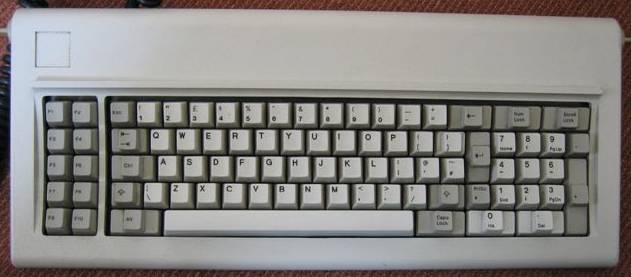The original IBM PC keyboard was a poor cousin to today’s monster, aircraft carrier-sized keyboards. The pitiful thing had only 83 keys. That seems like way too many, but keep in mind that the typical HDTV remote has about 90 buttons. It puts things in perspective.
83. I had the joy of typing on one of those original IBM PC keyboards. I purchased an IBM 5150, the original PC (sold without a hard drive) back in 1985 or so. Bought it used from my employer, but then I spiffed up the system with lots of extras. A newer keyboard was not one of the extras.

The 83 key keyboard was notable because the function keys — only ten of them — were on the left side of the keyboard, not along the top as you see them today.
WordPerfect, the original DOS version, was designed assuming that the Function keys were off to your left. That made its weirdo F-key combinations a lot easier to type.
What’s missing from the original 83-key keyboard is evident by studying its descendants:
84. The next keyboard to come out was the 84-key keyboard. The extra key? The seldom-used (if ever) SysRq key.
SysRq stands for System Request, and it was supposed to be a vital key in the next greatest PC operating system, OS/2. The success of both OS/2 and the SysRq is pretty much evident; both died about the same time.
Today, the SysRq key — still unused — shares the Print Screen key. It’s a dud, so did computer keyboards go back to the 83-key model? No!
101. The next common PC keyboard was the 101-key model, which was popular from the early 1990s to the mid-2000s.
The difference between 101 and 84 is 17. Most of those new keys are nestled between the numeric keypad and the alphabetic parts of the keyboard. Add in two new Function keys, F11 and F12, plus some symbol keys around the numeric keypad and you have 18 keys.
Yes, that 18 and not 17 because the SysRq key was doubled-up on the Print Screen key. The total is still 101.
104. The next big leap in computer keyboards was the 104-key keyboard, which is still pretty much the model you’re using today. The extra three keys? Two Windows keys and a Context or Menu key.
1,000,000. The computer industry doesn’t have a standard computer keyboard today. Even what you would consider standard isn’t; European keyboards feature special keys, there are special keyboards for special alphabets, and then you have all those bonus buttons on some keyboards, such as those that adjust the brightness, volume, or play media.
Don’t get me started on laptop keyboards!
The future of the keyboard is still cemented in our culture, until computer voice input is perfected. Even then, such a thing would require a new operating system. I’m sure someone on some university campus somewhere is working on that new paradigm. Let’s call it the zero-key keyboard.


One of the fun things about laptop keyboards is that you never know what you’re going to get. I’ve used netbook keyboards before (awful), Macbook keyboards, Godzilla-sized laptop keyboards, you get the idea. I’ve never been much for HP laptop keyboards; then again they do have a record of making some of the worst-built laptops out there.
The best laptop keyboard I’ve used was the one in my now-dead IBM ThinkPad 360CE. It wasn’t a buckling spring Model M but it came quite close and had very good tactile feedback. Perhaps that’s why IBM classed it in the Model M family.
Comment by linuxlove — January 16, 2013 @ 8:03 am
I generally buy IBM/Lenovo laptops. The keyboard is okay; I’m going to cut slack on any laptop keyboard. The problem with IBM/Lenovo is their naming conventions. They have three major classes of laptop, then about seven subclasses, then about a dozen models in each subclass. It’s maddening! Why don’t they just have three different laptops that you can customize? I don’t get it…
Comment by admin — January 16, 2013 @ 11:39 am